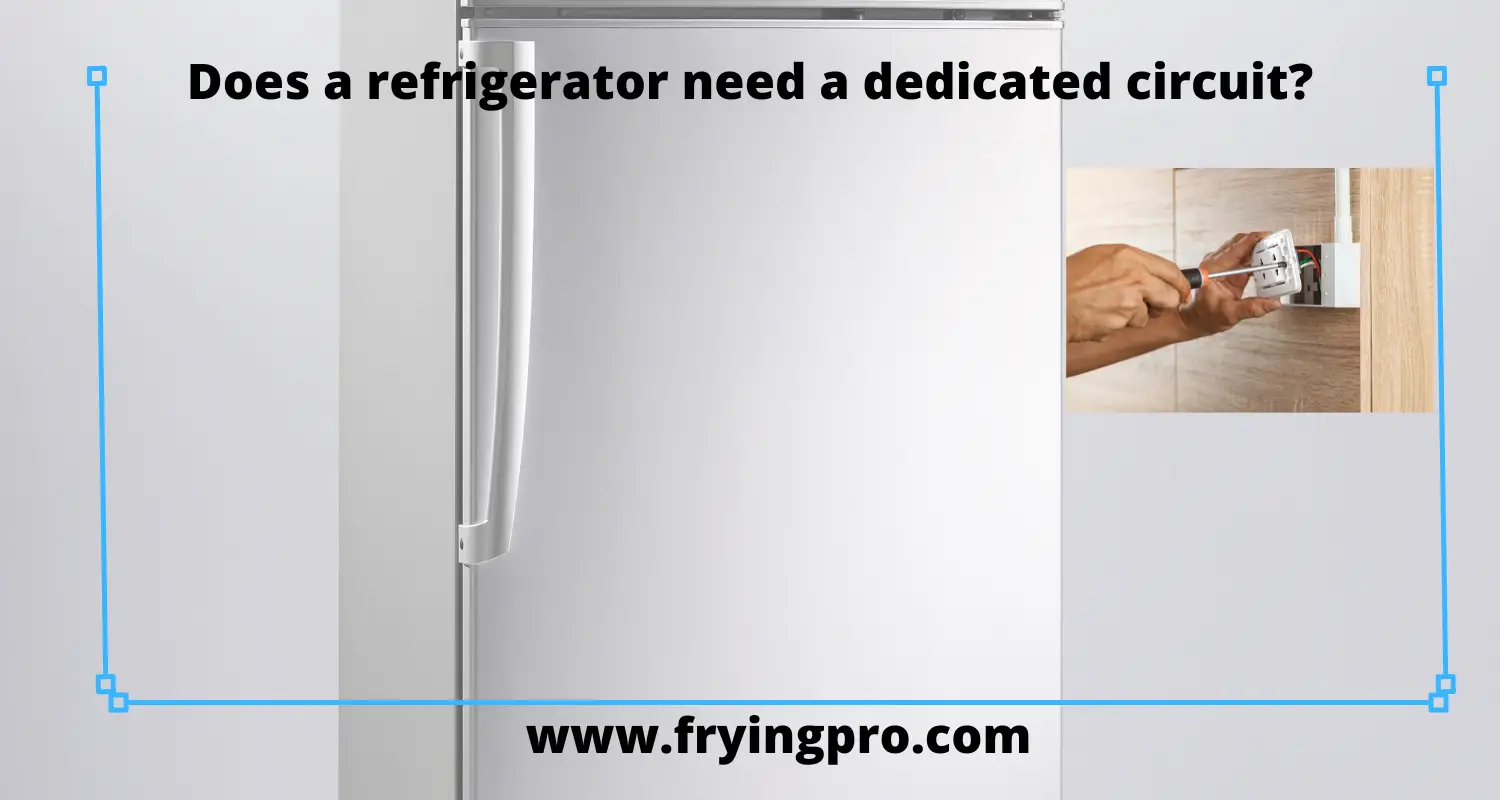Most homeowners know that large appliances like washers and dryers need their dedicated circuits to run safely and efficiently. But what about your refrigerator?
Does a refrigerator need a dedicated circuit? You may not realize it, but your fridge is one of the most hardworking appliances in your home. It runs 24/7, 365 days a year, so it’s essential to ensure it has the electrical power to keep your food cold.
Does a refrigerator need a dedicated circuit?
Yes, a refrigerator needs a dedicated circuit. Most refrigerators typically run at 360-720 Watts; however, the peak usage can spike up to 1800 Watts. Spikes in the power supply can trip breakers and disrupt your household power supply. To avoid such a situation, you must install dedicated circuits of 15-20 amps (1800-2400 watts) with your refrigerator.
| Types of Circuit | Power load capacity |
| 15 amp | 1800 Watts |
| 20 amp | 2400 Watts |
| 30-50 amp | 12,000 Watts |
What is a dedicated circuit?
A dedicated circuit is an electrical line intended to power a single appliance or device. It is essential to have dedicated circuits for specific devices to ensure that the electrical load is not too great on any one circuit, which could cause a breaker to trip or even fire.
Dedicated circuits are typically used for high-powered appliances such as air conditioners, clothes dryers, and ovens. They can also be used for devices that require a lot of power when they are first turned on, such as power tools.
To determine if an appliance needs a dedicated circuit, you can look at the nameplate, which should list the voltage and amperage requirements.
How many amps does a refrigerator draw on startup?
A refrigerator draws the most amps on startup. This is because the compressor and condenser fans start up and run at full speed. The Startup current can be as high as 15-25 A for a fridge. The average home has a 120 V supply, so the power draw on startup is around 3,000-6,000 Watts.
The amp draw will decrease once the fridge reaches its operating temperature and the compressor and fans slow down. The Running current for a fridge is usually between 1-2 A. So, for a 120 V supply, the power draw would be around 120-240 Watts.
The power consumption of a fridge can vary depending on the size of the fridge, whether it is a chest or upright freezer, how old it is, and how often the door is opened.
What happens if a refrigerator is not on a dedicated circuit?
If a refrigerator is not on a dedicated circuit, it may not function properly. The fridge could overheat and cause food to spoil. In some cases, the fridge could start a fire.
Refrigerators require a lot of power to run. If they are not on a dedicated circuit, they may overload the circuit and cause a power outage. In extreme cases, the fridge could start a fire.
To avoid these problems, it is essential to ensure your refrigerator is on a dedicated circuit. If you are unsure whether your fridge is on a dedicated circuit, you should contact an electrician to check for you.
Can you plug a refrigerator into a regular outlet?
You might wonder if you can plug a refrigerator into a regular outlet. The answer is yes, you can! However, there are a few things to keep in mind.
First, your refrigerator will use more power from a regular outlet than a dedicated circuit. This means you’ll want to ensure your refrigerator is the only thing plugged into that outlet.
Second, you’ll need to use a heavy-duty extension cord rated for 15 amps or more. A regular extension cord won’t be able to handle the amount of power your refrigerator needs.
Finally, make sure to check the voltage rating on your refrigerator. Most refrigerators need 120 volts, but some models require 240 volts. If unsure, consult the owner’s manual or contact the manufacturer.
Does the refrigerator need GFCI and a dedicated circuit?
Most homes have a refrigerator that is either hardwired or plugged into a dedicated circuit. However, some people wonder if their refrigerator needs a GFCI (Ground Fault Circuit Interrupter) outlet and/or a dedicated circuit. The answer is: it depends.
If your refrigerator is plugged into a standard 120-volt outlet, it does not need a GFCI outlet. However, if your refrigerator is plugged into a 240-volt outlet, it needs a GFCI outlet. In terms of dedicated circuits, most refrigerators do not require one. However, if your refrigerator is huge or uses a lot of power, you may consider installing a dedicated circuit.
So, does the refrigerator need GFCI and/or a dedicated circuit? It ultimately depends on the specific fridge and how it is being used.
What size breaker do I need for a refrigerator?
You will need a breaker of at least 15 amps for a standard household refrigerator. If your refrigerator is larger or uses more power, you may need a 20-amp breaker. To be safe, always check the manufacturer’s recommendations before purchasing a breaker.
Can a fridge share a circuit?
Yes, a fridge can share a circuit with other appliances as long as the sum of the appliance currents does not exceed 15 amperes.
For example, if a toaster and coffee maker are each plugged into the same circuit as the fridge, and each has a current draw of 8 amperes, the total current draw on the circuit would be 12 amperes, which is within the safe limit. However, if another appliance were added to the circuit with a current draw of 6 amperes, the total current draw would be 18 amperes, which would exceed the safe limit and could result in a fire.
Therefore, it is essential to always check the ratings of appliances before plugging them into a circuit.
Can a refrigerator and microwave be on the same circuit?
Yes, a refrigerator and microwave can be on the same circuit. The maximum amperage for most circuits is 15 amps, and a refrigerator and microwave usually require less than 15 amps.
If the appliances are on the same circuit, they will share the amperage and may not operate at their full potential. It is recommended to have each appliance on its circuit to prevent overloading the circuit.
How much does it cost to install a dedicated 20-amp circuit?
Installing a dedicated 20-amp circuit in your home can be a costly endeavor. The national average cost for this project is $1,200, with most homeowners spending between $800 and $1,500. This price includes the cost of materials and labor.
Why does my refrigerator keep tripping the GFCI?
When your refrigerator trips the GFCI, it is usually because of a problem with the compressor. The compressor circulates the coolant in the fridge and keeps the temperature inside the stable. If the compressor isn’t working correctly, it can cause the coolant to leak, which will trip the GFCI.
Several reasons your refrigerator’s compressor might not be working correctly. One possibility is that the fridge is overloaded and needs to be cleaned out.
Another possibility is that there is a problem with the electrical supply to the fridge. If you suspect this is the case, you should call an electrician to check it out.
Can I replace a 40-amp breaker with a 30-amp breaker?
It is not recommended to replace a 40-amp breaker with a 30-amp breaker. While a 30-amp breaker can safely handle a load of up to 240 volts, a 40-amp breaker is designed to handle loads of up to 415 volts.
Replacing a 40-amp breaker with a 30-amp breaker could cause the circuit to overload, leading to a fire.
Conclusion
Yes, a refrigerator needs a dedicated circuit. The National Electrical Code (NEC) requires that refrigerators have a dedicated circuit. This is because refrigerators are one of the few appliances that run continuously and use a lot of power. A dedicated circuit will ensure that your refrigerator has the power it needs to run efficiently.
References
On the accuracy of appliance identification based on distributed load metering data






